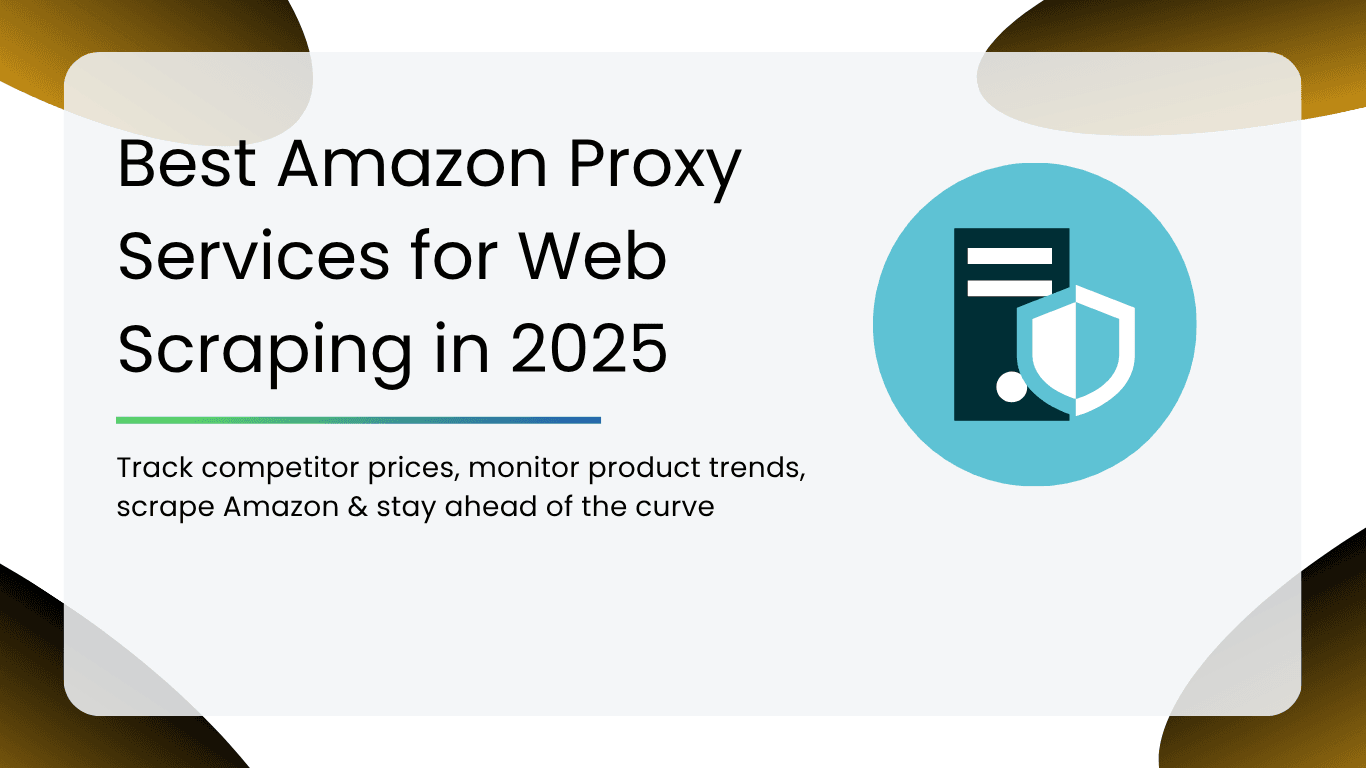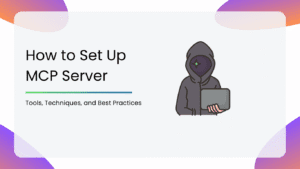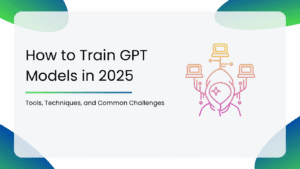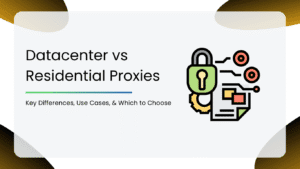Web scraping has become one of the most valuable tools for businesses that rely on data-driven decisions, and when it comes to e-commerce insights, Amazon is the goldmine. From tracking competitor prices to monitoring product trends, scraping Amazon helps businesses stay ahead of the curve.
But Amazon doesn’t make it easy. The platform has some of the strongest anti-bot measures in the world. That’s where proxies come in. Proxies act as intermediaries between your scraper and Amazon, masking your identity, rotating IPs, and keeping your data collection smooth and uninterrupted.
In this guide, we’ll explore why scraping Amazon is so tricky, how proxies make it possible, and the best Amazon proxy services for web scraping in 2025.
Why You Need Proxies for Scraping Amazon
Amazon’s systems are designed to stop automated bots in their tracks. From anti-bot detection and IP throttling to geo-blocks, every request you send to Amazon is closely monitored. If you make too many requests from a single IP address, or scrape data too quickly, you’ll face CAPTCHAs, slowdowns, or even permanent bans.
Here, proxies distribute your requests across multiple IPs, rotate addresses, and simulate genuine users, helping you scrape Amazon data safely and efficiently without triggering alarms.
Which Proxy Types Work Best For Amazon
| Proxy Type | Best For | Key Benefit |
| Rotating Residential Proxies | Large-scale, continuous scraping | Real user IPs = low block rates and high success for long-term data extraction |
| Sticky / Session (Static Residential Residential or ISP) Proxies | Tasks that require session continuity (e.g., login sessions, checkout flows, cart tracking) | Maintain the same IP for longer sessions to avoid re-authentication issues |
| Mobile Proxies | The toughest anti-bot defenses and “hairy” scraping targets | Use mobile carrier IPs that mimic genuine smartphone users for the highest trust rate |
| Datacenter Proxies | Quick, low-volume scraping tasks or testing environments | Fastest and most affordable option, but easier to detect and block by Amazon |
How to Choose the Right Proxy for Amazon Scraping
Here’s a quick checklist to help you pick the perfect fit for your Amazon scraping setup:
1. IP Pool Size & Geographic Coverage
A larger IP pool means fewer chances of repetition and detection. Look for providers that offer millions of IPs across multiple countries so you can mimic real user activity from different regions.
2. Rotation Options & Session Length
Choose between per-request rotation (a new IP for every request) or sticky sessions (one IP for several minutes).
- Per-request rotation is ideal for large-scale scraping where anonymity matters most.
- Sticky sessions work better when you need continuity. For instance, during checkout flows or while maintaining a login session.
3. Protocol Support: HTTP(S) & SOCKS5
Make sure your proxy provider supports HTTP(S) for general web scraping and SOCKS5 for advanced applications or scripts. SOCKS5 tends to be faster and more flexible when handling complex traffic.
4. Success Rate & CAPTCHA Handling
Always check the provider benchmarks for success rates and CAPTCHA frequency. Many reputable proxy providers publish these stats on their sites or in third-party reviews.
5. Pricing Model That Matches Your Needs
Proxies are priced differently:
- Per GB: Best for heavy data usage
- Per-IP: Suitable for consistent, static setups
- Subscription-Based: Offers predictable monthly costs
6. Extra Features & Support
Top-tier proxy services go beyond raw IPs. Look for added perks:
- Built-in scraping APIs for Amazon or e-commerce data
- Browser extensions for easy setup CAPTCHA-solving integration
- Reliable documentation and customer support for troubleshooting
Comparison Table of Best Amazon Proxy Services for Web Scraping in 2025
| Provider | Average Success Rate | Notable Features | Ideal For |
| Decodo | ~98% | High anonymity, flexible session control, 115M+ IPs, strong Amazon focus | Budget-conscious users seeking reliability |
| Bright Data | ~98% | Advanced scraping tools, Web Unlocker API, 24/7 support | Enterprises needing extensive features |
| Oxylabs | ~98% | Web Unblocker, SOCKS5 support, enterprise-grade tools | Large-scale scraping operations |
| ScraperAPI | ~98% | Simple API, Amazon-specific tools, high success rate, cost-effective | Developers needing quick integration |
| ProxyEmpire | ~98% | Ethical sourcing, self-service dashboard, Amazon-specific tools | Users valuing ethical practices and ease of use |
| Infatica | ~95% | SOCKS5 support, affordable pricing, global IP coverage | Small to mid-sized businesses |
| Rayobyte | ~98% | Fast and reliable infra, server-based proxies, cost-effective | Users needing scalable, budget-friendly solutions |
| IPRoyal | ~95% | Over 32M IPs, browser extension, intuitive dashboard, ethical sourcing | Individual and small businesses |
Best Amazon Proxy Services for Web Scraping in 2025
| Table of Contents |
| 1. Decodo |
| 2. Bright Data |
| 3. Oxylabs |
| 4. ScraperAPI |
| 5. ProxyEmpire |
| 6. Infatica |
| 7. Rayobyte |
| 8. IPRoyal |
1. Decodo
Decodo is a full-stack scraping & proxy platform that has built a strong reputation for handling challenging targets like Amazon. They offer a dedicated Amazon Scraper that combines a large pool of proxies with ready-made templates, browser fingerprinting, and built-in anti-bot bypass features. You can extract Amazon product lists, details, reviews, customer Q&A and more with support for JSON/HTML output and automatic retries for failed requests.
Key Features:
- Huge IP Pool: Over 125 million IPs (residential, mobile, static, datacenter) across 195+ locations.
- Purpose-Built Amazon Scraping Features: Offers templates, anti-bot bypass, retry logic, and browser fingerprints.
- Clear Integration: Supports HTML/JSON, which is easy for developers to hook into.
- Competitive Pricing: It strikes a good “value vs performance” balance.
- Free Trial: You can test before committing.
Cons:
- Learning Curve: While the setup is easier, using advanced features requires some technical expertise.
- Overkill for Small Scraping Needs: If you only have minimal, low-volume tasks, a full-feature API might be more than you need.
Review: If you’re planning to lead your 2025 scraping strategy with Amazon data, Decodo is absolutely worth considering. It ticks many of the must-haves: large proxy pool, Amazon-targeted features, good integration. Make sure you run a pilot test to validate the success rate / CAPTCHA frequency for your specific use case.
2. Bright Data
Bright Data offers a robust suite of scraping tools and proxies, including a dedicated “Amazon Scraper” API that makes collecting product info, reviews, seller details and more from Amazon remarkably straightforward. Their service covers everything from single-product scraping to large-scale, geo-spanning data extraction.
Key Features:
- Broad Feature Set: With the Amazon Scraper API you can extract titles, seller name, brand, currency, availability, reviews count, and more.
- Flexible Deployment: Offers both API-based and no-code “plug-and-play” methods depending on your comfort level.
- Strong Enterprise Credentials: Trusted by thousands of customers globally and backed by a huge proxy network and infrastructure.
- Transparency in Pricing: Provides pay-as-you-go and tiered plans so you know the cost structure up front.
- Well-Documented and Supported: Tutorial resources for Amazon scraping and full API documentation exist to help you get started.
Cons:
- Higher Cost: The pricing is generous but not cheap; smaller scrapers or casual users might find it expensive.
- Steep Learning Curve: While they have no-code options, many features still assume some expertise.
Review: For 2025 Amazon scraping projects where reliability, volume, and advanced features matter, Bright Data deserves strong consideration. Just make sure you budget accordingly, and plan some time for setup and learning. A pilot test will really help you validate whether the success rate, CAPTCHA, latency and cost fit your personalized use case.
3. Oxylabs
Oxylabs’ Amazon Scraper API is part of their larger Web Scraper suite, designed specifically to pull product, pricing, review and seller data from Amazon across global marketplaces. For example, you can extract data like ASIN, seller names, availability, review count, localized content and more in JSON or HTML format. They also highlight a large proxy pool and built-in anti-bot mechanisms to support high-scale scraping.
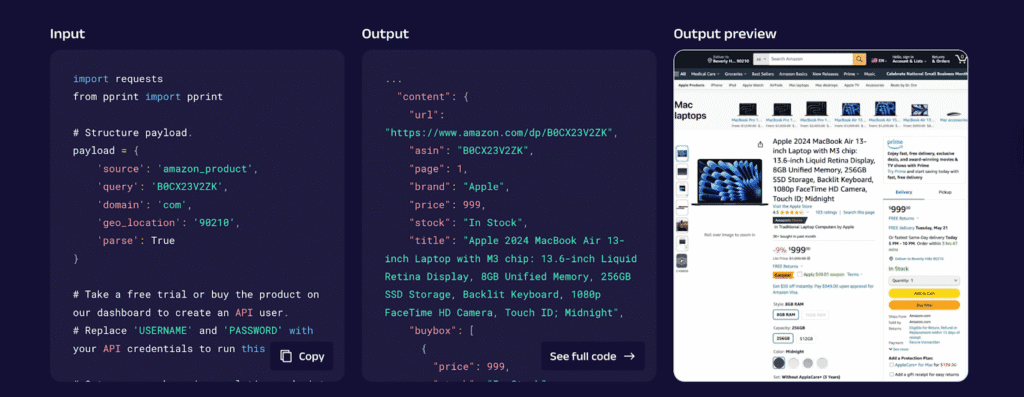
Key Features:
- Broad Global Coverage: The API supports Amazon domains in many geographies, enabling localization of data.
- Ready-to-Use Solution: Built-in scraping logic for Amazon (product pages, reviews, best-sellers) means less build effort.
- High Reliability: Users note consistent uptime, good support, and integration use.
- Detailed Documentation & Demo Tools: Tutorials on scraping Amazon reviews, price tracking, and more make onboarding smoother.
Cons:
- Premium Cost: As multiple reviewers note, Oxylabs is built for serious scale, and the cost/model may not fit lighter scraping needs.
- Billing & Flexibility: Smaller-scale usage or tasks may end up being less efficient compared to simpler plans.
Review: For 2025 Amazon scraping projects that are ambitious (e.g., multi-category, multi-region, frequent updates), Oxylabs deserves serious consideration. Be sure to run a small pilot using your target Amazon marketplace(s) to validate the API’s success rate, CAPTCHA frequency, and overall cost-per-data-point before committing long-term.
4. ScraperAPI
ScraperAPI offers a straightforward Amazon scraping solution that transforms product pages into structured JSON or CSV data with minimal setup. Designed for scalability and ease of use, it supports high concurrency and geotargeting across Amazon’s global domains.
Key Features:
- No-Code Interface: Ideal for marketers and analysts without coding expertise.
- High Success Rate: Achieves a near 100% success rate on Amazon domains.
- Advanced Anti-Bot Features: Handles CAPTCHA and IP blocks effectively.
- Flexible Output Formats: Supports JSON and CSV for easy integration.
- Geotargeting: You can access data from over 50 countries.
Cons:
- Limited Advanced Features: Lacks deep customization options compared to some competitors.
- Pricing Structure: May be less cost-effective for very high-volume needs.
Review: For 2025 Amazon scraping projects that prioritize ease of use and reliability, ScraperAPI stands out. Its combination of user-friendly features and robust performance makes it a strong contender in the market. As always, consider running a pilot test to ensure it meets your specific needs.
5. ProxyEmpire
ProxyEmpire offers a versatile Amazon scraping API designed for seamless data extraction from Amazon’s vast product listings. With a focus on speed, reliability, and scalability, it caters to both novice and professional users aiming to gather product details efficiently.
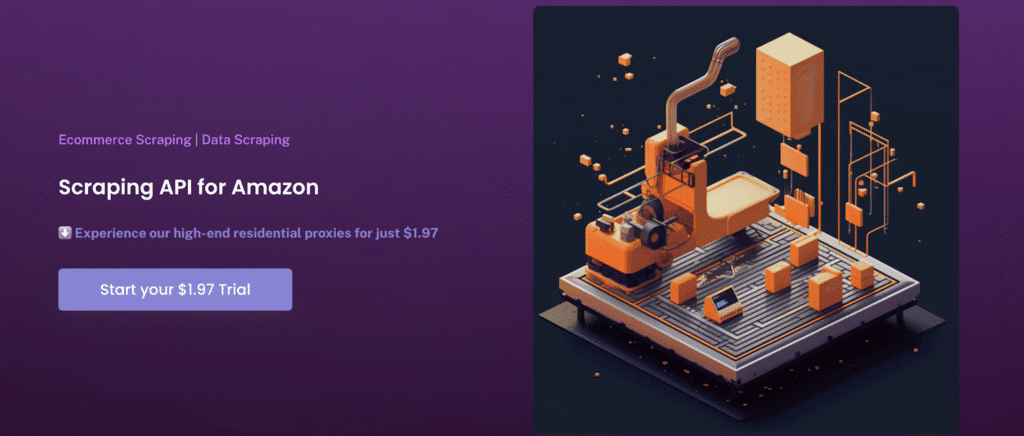
Key Features:
- High-Speed Performance: Delivers rapid data retrieval, ensuring timely access to Amazon product information.
- Scalability: Handles large volumes of data extraction, accommodating growing business needs
- User-Friendly Interface: Designed for ease of use, making it accessible for users with varying technical expertise.
- Advanced Anti-Bot Capabilities: Equipped with features to bypass Amazon’s anti-scraping measures, ensuring uninterrupted data access.
- Flexible Proxy Options: Offers a range of proxy types to suit different scraping requirements.
Cons:
- Paid Trial: Unlike some competitors, ProxyEmpire offers a paid trial, which might be a consideration for users seeking free testing options.
- Limited Documentation: Available documentation could be more comprehensive to facilitate smoother integration.
Review: For users seeking a powerful and scalable solution for Amazon data extraction, ProxyEmpire’s Amazon scraping API presents a compelling option. Its combination of speed, reliability, and advanced anti-bot capabilities positions it as a valuable tool for businesses aiming to leverage Amazon’s extensive product information.
6. Infatica
Infatica’s Amazon Scraper API is designed to facilitate seamless and reliable web scraping, with a focus on bypassing common issues like CAPTCHAs and IP blocks. The API uses a vast network of over 20 million proxy IPs worldwide, ensuring that businesses can perform web scraping and related tasks efficiently.
Key Features:
- Global Proxy Coverage: Access to over 20 million proxy IPs worldwide, providing extensive geographic coverage.
- Dynamic Content Support: Features a robust JavaScript rendering engine, enabling the scraping of dynamic content.
- Flexible Data Export: Supports multiple file formats for data export, including CSV, XLSX, and JSON, facilitating easy data analysis.
- Scalability: Suitable for both small and large-scale projects, offering scalability to meet varying business needs.
- Free Trial: Offers a free trial period for new users to evaluate the service before committing.
Cons:
- Documentation: The available documentation could be more comprehensive to facilitate smoother integration.
Review: Infatica’s Amazon Scraper API offers a powerful and reliable solution for web scraping, with features like dynamic content support and flexible data export options. The extensive proxy network ensures high success rates in data collection. For businesses seeking a scalable and feature-rich Amazon scraping solution, this is a compelling option.
7. Rayobyte
Rayobyte has evolved from specializing in datacenter proxies to offering a comprehensive suite of proxy solutions. Their Amazon Web Scraping service is tailored for users seeking cost-effective and scalable solutions for extracting data from Amazon’s vast product listings.
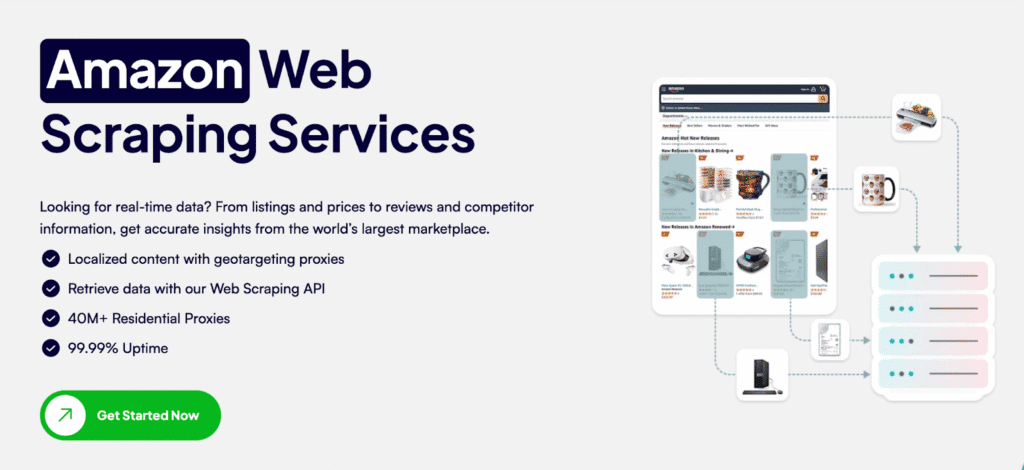
Key Features:
- Competitive Pricing: It offers some of the most affordable proxy rates in the industry.
- Flexible Proxy Options: The provider offers a range of proxy types, allowing users to choose the best fit for their specific scraping needs.
- Comprehensive Scraping Tools: Rayobyte provides additional tools such as Web Scraping API and a Web Unblocker, which can simplify the scraping process and enhance data extraction efficiency.
- Provides Resources: It offers extensive tutorials and guides on web scraping, including specific instructions for extracting Amazon data, which can be beneficial for users.
Cons:
- Limited Customer Support: This is one potential area for improvement.
- Lack of Transparency: There is no clear information regarding the ethical sourcing of its proxies.
Review: Rayobyte offers a compelling option for Amazon web scraping. For users prioritizing affordability and scalability in their Amazon scraping endeavors, Rayobyte presents a viable option.
8. IPRoyal
IPRoyal is a budget-friendly proxy provider offering a diverse range of proxy types. Their services are designed to cater to various web scraping needs, including the extraction of Amazon product data. IPRoyal emphasizes ethical sourcing and provides a user-friendly interface with tools like proxy testers and browser extensions.
Key Features:
- Affordable Pricing: IPRoyal offers the proxy at a very reasonable rate as compared to its other competitors in the industry.
- Extensive IP Pool: With over 32 million residential IPs across 195+ countries, IPRoyal provides broad geographic coverage.
- Flexible Proxy Types: The provider offers a range of proxy types, allowing users to choose the best fit for their specific scraping needs.
- User-Friendly Tools: It provides additional tools such as Chrome proxy extension, proxy tester, and online proxy checker, which can simplify the proxy management and testing process.
Cons:
- Inconsistent Proxy Quality: The quality and reliability of IPRoyal’s proxies may affect scraping success rates.
- Lack of Transparency: There is no clear information on the ethical sourcing of its residential proxies.
Review: IPRoyal provides an affordable and flexible solution for Amazon scraping, offering multiple proxy types and helpful tools to streamline data extraction. However, proxy performance can vary, and customer support may not always be prompt.
Common Challenges When Scraping Amazon
1. CAPTCHA
Amazon often triggers CAPTCHA when it detects unusual traffic.
Fix: Use proxy providers or scraping APIs that include CAPTCHA handling, or integrate third-party CAPTCHA solvers to automate responses.
2. IP Bans / Subnet Blocks
Repeated requests from the same IP or subnet can lead to temporary or permanent bans.
Fix: Increase IP pool diversity and rotate IPs regularly.
3. JavaScript-Heavy Pages / Anti-Bot Fingerprinting
Amazon’s pages often rely on JavaScript and fingerprinting techniques to detect bots.
Fix: Use browser automation tools (like Puppeteer or Playwright) combined with residential or mobile proxies. Add fingerprint management solutions such as Multilogin or X Browser integrations.
4. Data Quality Drift
Over time, scraped data can become inconsistent due to changes in page structure or request throttling.
Fix: Rotate scraping strategies and adjust parsing scripts when Amazon updates page layouts or anti-bot measures.
Ethics & Compliance
1. Respect Website Rules
Always check Amazon’s robots.txt and terms of service before scraping. Scraping in violation of these rules can carry legal and ethical risks.
2. Use Data Responsibly
Handle scraped data carefully. Prefer official APIs when available to reduce risk and ensure compliance.
3. Seek Legal Guidance
For commercial or large-scale usage, consult legal counsel to ensure your scraping activities align with applicable laws and regulations.
Web scraping Amazon in 2025 requires more than just sending requests. It demands smart proxy usage, careful planning, and adherence to ethical standards. By combining the right tools, proxies, and best practices, businesses and developers can unlock Amazon’s rich data while minimizing risk and maximizing reliability.
If you want to know more from the world of proxy services, read our other personalized guides here:
FAQs
Setting up proxies is straightforward once you know your tool:
– Python: Pass the proxy in the request using proxies={‘http’ : ‘http://user:pass@IP:PORT’ , ‘https’ : ‘http://user:pass@IP:PORT’}.
– Scrapy: Define HTTP_PROXY in your settings or use a middleware to rotate proxies automatically. For rotating residential proxies, combine with a proxy list or API.
– Selenium / Browser Automation: Use browser capabilities/options to add proxies when launching the driver. For example, in Chrome, set –proxy-server=http://IP:PORT. For session continuity, stick to session/residential proxies.
Proxy type impacts performance and reliability:
– Datacenter Proxies: Fastest and cheapest, good for small-scale scraping. Higher risk of blocks can reduce accuracy.
– Residential / ISP Proxies: Slightly slower but more trusted by Amazon. Supports higher concurrency with fewer blocks and better data consistency.
– Mobile Proxies: Most trusted for anti-bot-heavy targets. Slower and more expensive, but extremely reliable for critical tasks.
Yes. Amazon uses geo-blocking and regional anti-bot rules:
– Always use proxies from the same country as the Amazon locale you’re scraping.
– Residential or ISP proxies are preferred over datacenter proxies in strict regions like Germany, UK, Japan.
– Some providers offer geo-targeted proxy pools for major Amazon marketplaces.
Most top providers support integration via:
– Direct API Endpoints: Many allow you to send requests directly to the proxy API without manually managing IPs.
– Proxy Rotation Middleware: Integrate in Scrapy or Python scripts to automatically rotate IPs per request.
– Browser Automation: Pass proxy credentials to Selenium, Puppeteer, or Playwright.
– Some providers (Bright Data, Oxylabs, ScraperAPI) also offer SDKs, libraries, or example scripts to streamline integration with existing scraping platforms.
Disclosure – This post contains some sponsored links and some affiliate links, and we may earn a commission when you click on the links at no additional cost to you.

